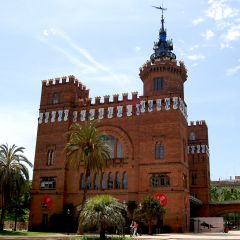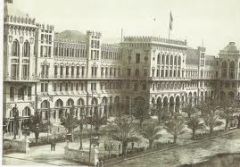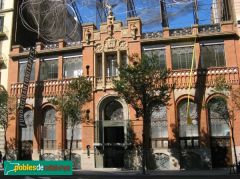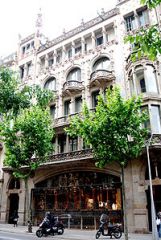![]()
![]()
![]()
Use LEFT and RIGHT arrow keys to navigate between flashcards;
Use UP and DOWN arrow keys to flip the card;
H to show hint;
A reads text to speech;
5 Cards in this Set
- Front
- Back

|
Three Dragons Castle: designed for International Exhibition 1888 (considered starting point of modernism in BCN); used as a coffee restaurant; strong example of modernisme because it used many bricks; ceramic panels at the top; uses iron, but it is much more simplified than Gaudi's iron; after the exhibition it was converted to an arts and crafts workshop; today it holds a natural science museum with animals; it was named in honor of a popular mid 19th century comedy
|
|

|
Gran Hotel Internacional 1888: there was so many people coming to Barcelona for the International Exhibition of 1888 (considered starting point of modernism in BCN) that they needed to create a new hotel to house them all; designed by Montaner; located by the sea, but it faced the city because at the time, the waterfront was not a rennovated area that was a popular place for the public to be; it was dismantled after the exhibition
|
|

|
Editorial Montaner i Simon; made by Montaner (1881-1886); comissioned by his uncle who had his own publishing company, the building was used to house this company, so it was very industrial; now it holds the Antonio Tapies museum; medievalism within building (eagle, roase windows, industrial wheels, mudejar influence); horse shoe arches that are typical of Arabian architecture; used a lot of iron and brick; iron is used on inside as a structural support; iron work on windows is very flat, not curvey and extravagant like Gaudi's; there are busts of important literary figures on outside; library on the inside that uses iron as well
|
|

|
Casa Thomas: designed by LLuis Domenenech i Montaner (1895-1898); the man who comissioned it was an important litographer; in the basement is where he did all of his work and litography, so it is very industrial; upstairs is where he lived, so it was a house that was divided into two parts; Montaner was trying to find a different architecture that breaks from classicism, but this building still has a lot of influence from historicism (ionic columns); later on, it was expanded and three floors were added, keeping respect to its original style
|
|

|
Fonda Espanya (1902-1903): designed by LLuis Domenenech i Montaner; it is a hotel; here is where Montaner begins to use ornamentation & arts and crafts; a lot of ceramic and woodwork on the walls; use of esgrafiado: light plaster relief that covers the top part of the walls; ceilings are covered in woodwork; capitals (top part of the columns) are all decorated in different coats of arms for different parts of Spain; dining room is decorated with an oceanic scene (mermaids with TWO legs) wood work at the bottom of the scene in the dining room, the water scene was influenced by Japonese art; chairs are all covered in a different coat of arms; it has an interior courtyard with ornamental reliefs in the courtyard, there is a girl with a sign that says Bon Dia (good day)
|

